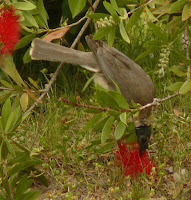3 Years of Birding in Carwoola
3 Years of Birding in the Carwoola area

This report is about birds so I will start with a couple of images of the birds of the area. Both are of large honeyeaters: a Red Wattlebird (a common resident) to the left and a Noisy Friarbird (a common breeding summer migrant)to the right. Both are feeding on Callistemon sp.
This is an informal report on the birds I have recorded in the Stoney Creek Gazette (hereafter ‘the Gazette’) since moving to the area in late January 2007. Since (for reasons that are not clear to me) I omitted to issue records for April 2007 the report is based upon observations for 34 months, concluding in December 2009. A version of this epic will hopefully be published in the Palerang Bulletin.
For most of 2007 the records are biased towards our home block. Since 2008 these records have been augmented by regular observations (over the whole area) from Julienne Kamprad of Quailrise in Hoskinstown. John Bisset of Widgiewa joined the systematic reporters in 2009 giving details from his property. In addition I have received, and included, observations of interesting species from several other readers of the Gazette. Many thanks to all reporters and all reports are welcome, especially of breeding species.
Area of Study
 Essentially the area for which I have recorded birds has been what I understand to be the catchment area of the Gazette, with a probable extension to Foxlow Bridge (because it is an ecologically interesting area and makes a nice bike ride) and Yanunbeenan NR. The approximate extent of the area is illustrated in the extract from Google Maps.
Essentially the area for which I have recorded birds has been what I understand to be the catchment area of the Gazette, with a probable extension to Foxlow Bridge (because it is an ecologically interesting area and makes a nice bike ride) and Yanunbeenan NR. The approximate extent of the area is illustrated in the extract from Google Maps.Overview
In the 34 months of observations 145 species have been recorded. 20 species were added to the list in 2008 while 7 species on the list were not recorded this year. Using the grouping I have employed for the Gazette, the breakdown of species follows.| Category | Count of Species all years | Count of Species 2009 |
| 1 Waterbirds | 24 | 22 |
| 2 Birds of Prey | 11 | 10 |
| 3 Parrots and Relatives | 12 | 11 |
| 4 Kingfishers and other non-songbirds | 23 | 22 |
| 5 Honeyeaters | 12 | 11 |
| 6 Flycatchers and similar species | 15 | 15 |
| 7 Other, smaller birds | 40 | 39 |
| 8 Other, larger birds | 8 | 8 |
A highlight was the first definite record of Superb Parrots (see image to the left) in this area. They are birds whose range is normally to the NW of Canberra but have been spreading SE in recent years.
Frequency of observing species.
The next table shows the number of species by frequency of observation.| Frequency | # Species |
| Every Month | 24 |
| 30-33 Months | 18 |
| 20-29 Months | 17 |
| 10-19 Months | 29 |
| 2-9 Months | 41 |
| One month | 16 |
| Total | 145 |
29% of the species have been recorded in 30 or more of the 34 months. and 24 species in every month (since 2008 Red Wattlebird and White-winged Chough were missed in one month). These 24 species observed in all months are shown in the following list. I have put an asterisk against those featuring in the 30 species most common in revegetation plots as listed by Greening Australia (GA) in their book “bringing birds back”. 14 species are common to both lists, with several of those in the GA list being migrants to the region and thus not likely to feature in an “all months” list.
Australian Wood Duck, Galah, Sulphur-Crested Cockatoo, Crimson Rosella*, Eastern Rosella*, Laughing Kookaburra, White-throated Treecreeper, Weebill*, Striated Thornbill*, Yellow‑rumped Thornbill*, Buff-rumped Thornbill*, Spotted Pardalote, Willie Wagtail*, Magpie‑lark*, White-eared Honeyeater*, Noisy Miner, Grey Butcherbird, Australian Magpie*, Pied Currawong*, Australian Raven*, Little Raven, Welcome Swallow, Common Starling*, House Sparrow.
Breeding Birds
Particular importance is attached to the birds which breed in an area, since if breeding habitat is depleted the species will not be sustained. The following list of 43 species observed as breeding in the area is based upon a broad definition of breeding, including activities from courtship display through nest-based activities to dependent young out of the nest. An asterisk denotes the 32 species observed breeding in 2009 (note that this includes parts of the breeding seasons 2008-09 and 2009-2010).Common Bronzewing*; Australasian Grebe*; Little Pied Cormorant*; Black-fronted Dotterel; Australian Wood Duck; Australian Shelduck; Pacific Black Duck*; Grey Teal*; Brown Goshawk*; Galah*; Eastern Rosella*; Tawny Frogmouth*; Dollarbird; Pallid Cuckoo; Horsfield's Bronze-Cuckoo; Welcome Swallow*; Tree Martin*; Fairy Martin*; Grey Fantail*; Willie Wagtail*; Leaden Flycatcher*; Rufous Whistler*; Grey Shrike-thrush* (see image of bird feeding a spider to the chick); Magpie-lark*; Striated Thornbill; Buff-rumped Thornbill; Yellow-rumped Thornbill*; Dusky Woodswallow*; Silvereye; Eastern Spinebill*; Yellow-faced Honeyeater*; Red Wattlebird*; Noisy Friarbird*; Diamond Firetail*; Red-browed Finch; Olive-backed Oriole; Satin Bowerbird*; Pied Currawong*; Grey Currawong*; Grey Butcherbird*; Australian Magpie*; Striated Pardalote*; Common Starling*.
 I will end, as I began, with images.
I will end, as I began, with images. The Tawny Frogmouths (to the left) bred again in a large Yellow Box in our lawn, and the whole family of 4 is still travelling around together. The Silvereyes (to the right ) turn up in most months: here the image shows two dining on the aphids infesting a honeysuckle. I conclude with an image of a pair of Australasian Pipits - common birds of the grasslands of the Hoskinstown Plain.








Comments